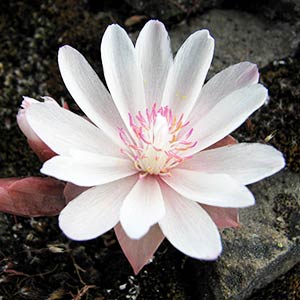Lewisia rediviva
Lewisia pygmaea
bitter root, bitterroot lewisia, resurrection flower
alpine lewisia, dwarf lewisia, least, pigmy bitter root, pygmy bitterroot
gradually ramified distally.
gradually ramified distally or shortly fusiform, rarely subnapiform.
procumbent to erect, 1–3 cm.
± prostrate or suberect, becoming reflexed in fruit, 1–6 cm.
basal leaves withering at or soon after anthesis, sessile, blade linear to clavate, subterete or grooved adaxially, 0.5–5 cm, margins entire, apex obtuse to subacute;
cauline leaves absent.
basal leaves withering at or soon after anthesis, ± sessile or gradually tapered to long petiole, blade linear to linear-oblanceolate, ± flattened, 3–9 cm, margins entire, apex acute to obtuse;
cauline leaves absent.
with flowers borne singly;
bracts 4–7(–8), whorled, subulate to linear-lanceolate, 4–10 mm, margins entire, apex acuminate.
2–4(–7)-flowered in racemose cymes or with flowers borne singly;
bracts 2, opposite, plus 1 subtending each successive flower if more than 1 flower, linear-oblong, linear-lanceolate, or lanceolate, (2–)4–10 mm, margins glandular-toothed, sometimes eglandular-toothed, apex acute.
pedicellate, disarticulate in fruit;
sepals (4–)6–9, broadly elliptic to ovate, 10–25 mm, scarious after anthesis, margins entire to somewhat erose, apex obtuse to rounded;
petals 10–19, usually rose to pink, sometimes lavender, sometimes with paler or white centers, or wholly white, elliptic, oblong, or narrowly oblanceolate, 15–35 mm;
stamens 20–50;
stigmas 4–9;
pedicel (1–)3–15(–30) mm.
pedicellate, not disarticulate in fruit, 1.5–2 cm diam.;
sepals 2, suborbiculate, broadly ovate, or obovate, 2–6 mm, herbaceous at anthesis, margins usually glandular-toothed, sometimes eglandular-toothed or rarely ± entire, apex usually truncate, sometimes rounded, obtuse, subacute, or apiculate;
petals 5–9, white, pink, or magenta, sometimes green at base, narrowly oblong, elliptic, or oblanceolate, 4–10 mm;
stamens (4–)5–8;
stigmas 3–6;
pedicel 2–5(–10) mm.
5–6 mm.
4–5 mm.
6–25, 2–2.5 mm, shiny, minutely papillate.
15–24, 1–2 mm, shiny, smooth.
= 26, 28.
= ca. 66.
Lewisia rediviva
Lewisia pygmaea
Varieties 2 (2 in the flora).
Native Americans commonly ate the boiled roots of Lewisia rediviva.
(Discussion copyrighted by Flora of North America; reprinted with permission.)
The circumscription and diagnosis of Lewisia pygmaea is problematic because of morphologic variability, intermediacy, and/or hybridization with L. nevadensis (see L. T. Dempster 1990). In the range of typical forms of L. nevadensis (see discussion under 11. L. nevadensis), one or more forms of L. pygmaea will also occur, but at higher elevations. Segregates of L. pygmaea recognized elsewhere as species include L. glandulosa, which occurs in rocky substrates above 3000 m in the central and southern Sierra Nevada and is characterized by elongate, sinuous taproots (L. T. Dempster 1990); and L. sierrae, which occurs in moist flats above 2400 m in the central Sierra Nevada and includes diminutive plants with irregularly eglandular-toothed (occasionally entire) sepals (B. Mathew 1989b). Dempster postulated that the variable and widely distributed L. pygmaea represents a hybrid species derived from L. nevadensis and L. glandulosa.
(Discussion copyrighted by Flora of North America; reprinted with permission.)
1. Basal leaf blades clavate to narrowly oblanceolate, grooved adaxially; sepals 10-12(-15) mm; petals 15mm; stamens 20-30 | var. minor |
1. Basal leaf blades linear, subterete, not grooved adaxially; sepals 15-25 mm; petals 18-35 mm; stamens 30-50 | var. rediviva |
- Local floras:
BC,
CA,
OR,
WA
- Local Web sites:
CalFlora,
CalPhotos,
Flora NW,
PNW Herbaria,
Turner Photog.
WildflowerSearch
iNaturalist (observations)
USDA Plants Database
- LBJ Wildflower Center
- SEINet
- Plants of the World Online
- Encyclopedia of Life
- Wikipedia
- Google Image Search


